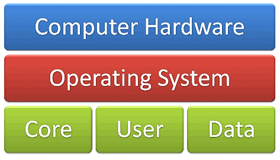How to Save the PC, or at Least Your Bacon
By Harry McCracken | Monday, September 21, 2009 at 2:27 pm
 TechRepublic’s Jason Hiner has a post up with the provocative title “How to Save the PC,” including a reader petition aimed at Microsoft and Apple. From the name, I thought it involved a strategy for keeping traditional PCs relevant in an era of powerful phones and an almost-omnipresent Internet. But Jason’s crusade is both less lofty and very sensible: He thinks that Windows and OS X should invisibly partition hard disks into separate sections for the operating system, user settings, and user documents and other data, thereby helping to shield irreplaceable stuff from damage and making it easier to get back up and running if you have an OS catastrophe.
TechRepublic’s Jason Hiner has a post up with the provocative title “How to Save the PC,” including a reader petition aimed at Microsoft and Apple. From the name, I thought it involved a strategy for keeping traditional PCs relevant in an era of powerful phones and an almost-omnipresent Internet. But Jason’s crusade is both less lofty and very sensible: He thinks that Windows and OS X should invisibly partition hard disks into separate sections for the operating system, user settings, and user documents and other data, thereby helping to shield irreplaceable stuff from damage and making it easier to get back up and running if you have an OS catastrophe.
Makes sense to me. I’ve always been surprised that operating-system companies in general haven’t put way more emphasis on features designed to protect data–Time Machine, the flagship feature of Apple’s OS X 10.5 Leopard being a notable exception. Microsoft has an amazingly long history of providing Windows backup apps that are unsatisfactory in one way or another: The one in Windows 7 is much better than Windows Vista’s, but only the version in higher-end editions of Win 7 can back up to a network drive. Which seems a little like a car company cheaping out on the airbags in its least pricey cars.
It’s not just OS companies, though. I use Photoshop more than any traditional app that isn’t a browser. The whole point of the program is to create deeply sophisticated documents, ones that can be mighty hard to recreate from scratch. And Photoshop is bursting at the seams with features–but there’s no way to auto-save your work, a simple option that would make it really, really hard to lose your work when Photoshop crashes. (Which it does, at least on my Mac.)
In the world of Web-based apps such as Google Docs and Zoho and Microsoft’s upcoming Office Web Apps, seamless, automatic backup of everything is the default way of doing things. Can anyone explain to me why it’s not that way everywhere there’s software–with versioning and unlimited undo so you can restore your documents to exactly the state you desire?
4 Comments
Read more:













September 21st, 2009 at 2:45 pm
Often I will create a second partition on a computer I have nuked & paved, then, once all apps are loaded, re-direct the various accounts’ “My Documents” shortcuts to folders on that partition. When the system is so equipped, it will be on a separate HDD altogether. If the system needs a N&P again the docs are still on that separate part. and all that’s missing are emails and program settings (everything but docs remain in “Docs & Settings on 1st part.) Makes life easier for me, and easier for the customer to perform backups.
September 21st, 2009 at 3:15 pm
More than once, I have saved my behind by partitioning a large hard drive and placing the system files on one and the data files on another partition. I recall under XP’s various upgrades and various software venders changing/adding whatever.dll to the system directory that I ran out of space. Also, [programs defaulted to the c:documents directory. I’ve moved to a MAC and haven’t partitioned the hard drive for fear of running into a ‘how big’ issue and a software defaults issue.
September 21st, 2009 at 4:39 pm
I always created a second smaller partition just for the operating system. For Windows, it makes an upgrade install much easier; but I still use clean install more. And each time before I clean-install, I clone the partition to an external hard drive just in case something happens.
Another thing I like about this idea is apps from both OSes can edit data on the data partition, provided both can read and write in the format the partition is in. I accomplished this in Windows and OSX using NTFS-3G in OSX. I even through Ubuntu on another partition just to see if it writes to NTFS; it does.
February 8th, 2012 at 1:09 pm
We should always make a back up for our pC. how ever you have also expained it very well. 🙂